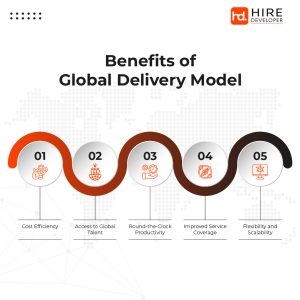Expanding a business across borders is exciting, but it’s never simple. Many brands encounter major roadblocks when scaling internationally: a lack of local insights, rising operational costs, inconsistent service delivery, and time zone differences. These challenges can stall growth or, worse, erode customer trust.
This is where the Global Delivery Model comes into play. It allows brands to distribute operations across countries to manage costs, boost efficiency, and deliver services around the clock. By blending a local presence with offshore support, brands can stay close to their customers while operating in sync with global teams. This model isn’t just for tech giants, it’s increasingly becoming the go-to approach for any brand aiming to grow globally without compromising quality or control.
This guide offers a clear breakdown of how the Global Delivery Model works, its essential components, and how it can help your brand grow smarter, not just bigger.
Defining the Global Delivery Model
A Global Delivery Model (GDM) is a strategic framework that distributes work across multiple geographical locations to optimise cost-efficiency, performance, and access to skilled talent. It blends both local and international resources to carry out business functions more effectively, especially in areas like technology services and customer support.
Typically, the model consists of three core components:
- Onshore Teams: Located in the same country as the client, these teams manage direct communication, ensure compliance with local regulations, and oversee customer engagement.
- Offshore Teams: Based in other countries, often where labour costs are lower, these teams handle software development, back-end support, and operational tasks.
- Nearshore Teams: Positioned in regions with similar time zones to the client, nearshore teams help bridge coordination between onshore and offshore counterparts, ensuring smoother collaboration.
This structure enables organisations to leverage time zone differences for uninterrupted productivity. By handing off tasks between geographically dispersed teams, companies can maintain a “follow-the-sun” workflow, ensuring round-the-clock operations and faster project delivery.
Historical Context and Evolution of the Global Delivery Model
The concept of the Global Delivery Model (GDM) gained prominence in the early 2000s, largely driven by IT services companies such as Infosys, TCS, and Wipro. Initially, the emphasis was on cost savings by offshoring development tasks to countries like India. Over time, however, the model evolved to include:
- Strategic nearshoring to enhance communication and minimise time zone differences.
- A stronger focus on governance is needed to effectively manage distributed teams using common standards and performance metrics.
- Advanced technology integration to enable real-time collaboration and ensure secure data handling.
Today, organisations outside the IT sector, including those in retail, finance, banking, and healthcare, are leveraging the Global Delivery Model for a wide range of functions, from marketing and design to customer support and logistics.
Key Components of the Global Delivery Model
A Global Delivery Model functions effectively only when its core components are clearly defined. These components are not merely teams or roles; they are structured systems that ensure uninterrupted delivery, regardless of geographic location.
- Onshore Operations: Onshore operations are managed by teams located in the same country as the client. These teams lead client communications, gather project requirements, and ensure that deliverables align with local business norms. They are especially vital in industries governed by strict regulations and sensitive to cultural expectations.
- Offshore Operations: Offshore operations are based in countries where labour costs are lower and technical talent is abundant. These teams typically manage software development, quality testing, data processing, and 24/7 support services. Nations such as India and the Philippines are widely recognised for their skilled offshore talent pools.
- Nearshore Operations: Nearshore operations are established in countries that are geographically closer or share overlapping time zones with the client. This setup enables better real-time communication and partial workday alignment. For instance, a U.S.-based company may collaborate with a nearshore team in Mexico or Costa Rica to enhance coordination and responsiveness.
Each operational type fulfils a distinct role. When synchronised effectively, they form a cohesive delivery framework that enables work to transition seamlessly across time zones. This model ensures that projects progress continuously, even as one team signs off and another begins.
The Role of Technology and Infrastructure in GDM
A successful Global Delivery Model is impossible without a strong technological foundation. To avoid communication gaps and delays in project delivery, organisations must rely on collaborative tools, secure communication channels, and unified digital platforms.
Essential tools include:
- Project management software like Jira or Asana enables real-time task tracking and progress visibility.
- Version control systems, such as Git to ensure code consistency and traceability across distributed teams.
- Secure communication platforms like Slack or Microsoft Teams facilitate seamless, cross-location collaboration.
- Time tracking applications to manage shift overlaps and monitor productivity effectively.
Beyond tools, companies need to invest in robust infrastructure, secure servers, end-to-end data encryption, and adherence to compliance standards. These measures help ensure that customer data is protected and responsibly handled across all operational teams.
Reliable internet connectivity, dependable hardware, and comprehensive backup systems are non-negotiable. Teams must have the ability to operate without interruptions and seamlessly switch work locations when necessary.
Benefits for Globally Expanding Brands
Brands that adopt a Global Delivery Model often do so for cost efficiency. However, the benefits extend far beyond financial savings. This model enables real-time execution, access to diverse global skillsets, and enhanced service quality. Here are five key advantages for companies planning or managing international growth:
1. Cost Efficiency: A Global Delivery Model significantly reduces labour and infrastructure expenses. Offshore locations offer competitive wages without compromising talent. For instance, hiring a software engineer in Eastern Europe or South Asia is substantially more cost-effective than in North America. This enables brands to scale their workforce while keeping payroll lean.
Beyond salaries, companies also save on real estate, utilities, and employee benefits by relocating support functions to lower-cost regions.
2. Access to Global Talent: Every region brings unique strengths. India produces a high volume of skilled IT graduates. Eastern Europe excels in engineering and cybersecurity. Southeast Asia offers multilingual customer support.
The Global Delivery Model empowers companies to leverage these regional strengths. Rather than being limited by local availability, organisations can build specialised teams tailored to their precise operational needs.
3. Round-the-Clock Productivity: With teams spread across time zones, work can progress continuously. For example, a design team in the U.S. may complete its day’s tasks, and a development team in Vietnam can seamlessly take over. This follow-the-sun model reduces project timelines and accelerates service delivery.
This 24-hour cycle isn’t just beneficial for tech projects it also boosts responsiveness in customer service and issue resolution, particularly in sectors like eCommerce and finance.
4. Improved Service Coverage: Today’s customers expect prompt, effective support. The Global Delivery Model places resources in various time zones, allowing customers worldwide to receive timely assistance.
For example, a company serving both North America and Europe can assign dedicated support teams to each region, avoiding overload and enhancing responsiveness. This strategy strengthens customer satisfaction and simplifies expansion into new markets.
5. Flexibility and Scalability: Business needs are dynamic. During product launches, companies must scale up support and marketing. In slower periods, they aim to reduce costs. A distributed delivery model enables this adaptability.
Brands can adjust team sizes based on location, workload, and budget. Non-core tasks can be delegated to offshore teams, while core operations remain onshore. This flexibility fosters agility and helps businesses navigate market changes with confidence.

HireDeveloper.Dev: Your Strategic Partner in Global Delivery Excellence
At Hire Developer, we empower businesses to scale globally by delivering tailored talent solutions that align perfectly with the Global Delivery Model (GDM). Our approach bridges the gap between onshore, offshore, and nearshore operations, providing seamless collaboration, rapid execution, and top-tier results across borders.
- Access to a Curated Global Talent Network: We offer immediate access to pre-vetted developers and technology professionals from strategic regions across the world. Whether you need front-end engineers in Eastern Europe, DevOps experts in India, or UX designers in Latin America, Hire Developer connects you with the right talent based on time zones, language, skill set, and cultural fit.
- Around-the-Clock Development and Support: With talent deployed across key global hubs, we enable a true “follow-the-sun” model. Your projects never sleep. As your local team signs off, our offshore or nearshore developers pick up the baton, ensuring uninterrupted development cycles, faster delivery, and real-time support.
- Seamless Integration with Onshore Teams: Our dedicated onboarding and communication protocols ensure our developers integrate effortlessly with your in-house or onshore teams. From Slack channels to Agile sprints, we adapt to your workflows not the other way around promoting unified collaboration and maximum transparency.
- Agile, Scalable, and Cost-Effective: Need to scale your development team for a product launch? Or streamline operations during a quieter quarter? Hire Developer offers on-demand talent scalability to fit your evolving needs. Our flexible contracts and global pricing models ensure you stay agile while reducing overhead.
- Secure, Compliant, and Enterprise-Ready: Security and compliance are non-negotiable in a distributed model. We ensure that all our engagements adhere to industry standards, including GDPR, HIPAA, and ISO practices. Our developers operate within a secure infrastructure using encrypted tools and follow best practices for code quality and data protection.
- Technology and Tools You Trust: Hire Developer teams are proficient in using cutting-edge platforms and tools, from project management (Jira, Trello, Asana) to code collaboration (Git, Bitbucket), and communication (Slack, MS Teams). This ensures seamless integration into your existing stack for a frictionless global delivery experience.
Your Global Team, Just a Click Away!
Looking to scale your digital capabilities globally? Hire Developer makes it effortless to hire Angular developers, Node.js developers, PHP developers, or Laravel developers to build powerful backend systems. Need great UI? Hire UI/UX designers who blend creativity with usability. For enterprise apps, hire Java developers or mobile pros to hire Android developers, iOS developers, or Flutter developers for flawless user experiences.
Want a solid CMS? Hire WordPress developers today. Automate and scale with ease hire Python developers, SEO experts, PPC experts, and AWS professionals. Tap into the future with AI hire ChatGPT developers or hire expert Salesforce developers for enterprise transformation.
Your tech dream team is ready. Let’s build something amazing together.
Conclusion
The Global Delivery Model is more than just an IT strategy, it’s a comprehensive framework that empowers brands to expand their operations, manage costs effectively, and deliver enhanced customer service at scale. By distributing work across onshore, offshore, and nearshore teams, organisations can ensure continuous operations, access diverse global talent, and remain agile in evolving markets.
For brands aiming for international growth, adopting this model is often the first meaningful step toward building sustainable global operations. While it requires thoughtful planning, structured execution, and the right technological support, the long-term benefits make it a smart and strategic move for businesses focused on intelligent growth.
By partnering with HireDeveloper.Dev, you’re not just outsourcing tasks; you’re unlocking a global workforce designed to help your business grow smarter, faster, and stronger. Hire Developer simplifies this complexity. We don’t just fill roles, we provide talent that delivers, collaborates, and innovates on a global scale.
Ready to build your global tech team? Contact us today to schedule a free consultation or hire top-tier developers tailored to your needs. Let’s scale your vision together.
Related Resources:
- How to Hire Salesforce Developers in 2025: Ultimate Guide
- Hiring an AI Developer for Your Custom Project: The Ultimate Guide
- How to Hire Top React JS Developers in the USA: 2025 Checklist
- How to Hire a Software Developer in Ohio: A 2025 Guide
- The Complete Guide to Hiring Laravel Developers in 2025
- AWS Partners in India: Best Cloud Consulting and Solutions Providers









